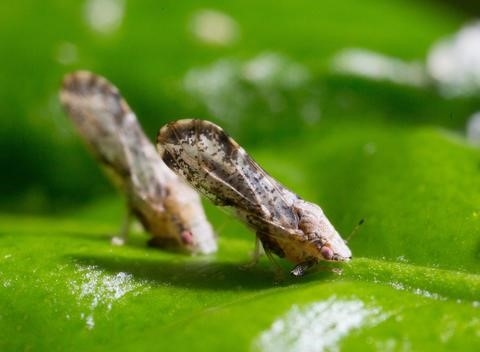Greening Bacterium Causes Changes in Psyllids
Recent studies, including a partnership project between Fundecitrus and the University of California, revealed that the citrus greening bacterium Candidatus Liberibacter asiaticus causes physiological changes in psyllids, posing additional challenges to management strategies. An increase in the number of eggs, more frequent dispersal flights over longer distances and greater attractiveness to the host are some of the changes observed in infected psyllids.
MORE DIFFICULT TO MANAGE
“Epidemiologically speaking, the changes we have been observing in psyllid behavior turn it into a much more problematic insect,” said Fernando Amaral, Fundecitrus agricultural engineer and post-doctoral student at the São Paulo University Luiz de Queiroz College of Agriculture.
The psyllid behavioral changes hinder the development of pheromone tools to attract the insect and improve its monitoring.
“It is becoming increasingly clear that the psyllid undergoes several changes, and this phenomenon not only poses difficulties to management, but also curbs the development of products to capture the insect,” added Fundecitrus researcher Haroldo Volpe.
Studies published between 2015 and 2024 revealed that psyllids infected with the greening bacteria can lay up to 100% more eggs than healthy insects, contributing to the growth of the psyllid population.
FREQUENT FLIERS
The studies also concluded that infected psyllids are more agitated when compared to healthy insects. In order to reach this conclusion, researchers placed adult insects from both groups on a platform. The teams noticed that infected insects flew, on average, after 50 seconds from the beginning of the observation period. The healthy subjects took around 150 seconds.
“Knowing that the insect flies more often and starts flying earlier demonstrates agitation and altered behavior, increasing its ability to spread greening,” said Volpe.
Yet another conclusion of the studies is that infected psyllids perform more frequent dispersal flights.
“Psyllids infected with the greening bacteria have a 45% higher rate of long flights when compared to healthy insects,” said Amaral.
In other words, the infected psyllid will fly longer distances and further spread the disease. Moreover, infected psyllids will also have a greater need to feed (forage) on more shoots and consequently will further disseminate the disease.
SUSCEPTIBILITY TO INSECTICIDES
On the other hand, the susceptibility of infected insects to insecticides is greater than that of healthy insects. Psyllids infected with the greening bacteria require a 20% to 313% lower concentration of insecticides to achieve the same mortality rate as healthy insects. This happens because the bacteria interferes with the psyllid metabolization of these products, which hinders their detoxication process.
CONTINUE COMBATING DISEASE
Fundecitrus General Manager Juliano Ayres emphasized the need for citrus growers to remain aware of the measures used to combat the disease in the field.
“The more diseased plants in groves without appropriate psyllid control, the more contaminated insects there will be and, consequently, the faster the disease will spread,” Ayres said. “Therefore, it is essential to continue to eliminate diseased plants from groves and keep up strict control of the insect on these plants.”
Source: Citricultor, Fundecitrus
CLas-Positive Psyllid Sample in Riverside County
July 26, 2024
An adult Asian citrus psyllid (ACP) sample from a residential property in the San Jacinto Valley area of Riverside County, California, has tested positive for Candidatus Liberibacter asiaticus (CLas), the bacterium that causes huanglongbing (HLB).
The positive sample was collected as part of the Multi-Pest Risk Survey on a residential property in Hemet. It was confirmed positive for CLas on July 17 by the Citrus Research Board's Jerry Dimitman Laboratory. Nymphs were also collected from the property and tested negative for CLas. This is the first confirmed CLas-positive adult ACP found in the San Jacinto Valley area.
An HLB quarantine zone will not be established as a result of this CLas-positive ACP detection. However, California Department of Food and Agriculture (CDFA) staff is conducting surveys and collecting samples from the property and all HLB host plants that are located within a 250-meter radius around the find, per the ACP/HLB Action Plan.
It is crucial that ACP populations continue to be controlled properly in order to stop HLB from spreading, advised California's Citrus Pest & Disease Prevention Program.
While CDFA is not requiring mandatory treatment for area commercial growers, those who wish to take proactive steps to protect their groves or who have additional questions can contact Riverside County Grower Liaison Sandra Zwaal.
In September 2023, a CLas-positive ACP sample was collected from a residential property in California's Ventura County. That sample came from a residential citrus tree in the southwest area of Santa Paula. An HLB quarantine zone was not established as a result of that detection, either. While that first confirmation of a CLas-positive ACP in Ventura County was concerning, HLB was not detected in any Ventura County citrus trees. Learn more here.
Source: Citrus Pest & Disease Prevention Program
